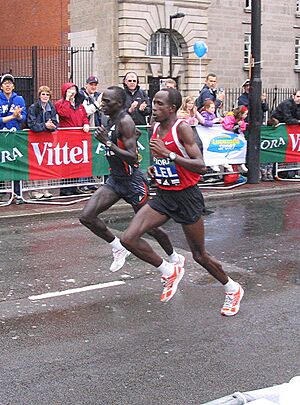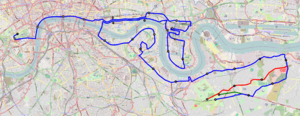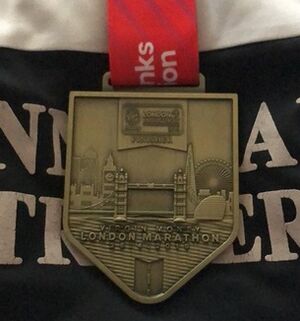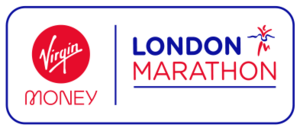London Marathon facts for kids
Quick facts for kids London Marathon |
|
|---|---|
 |
|
| Date | April |
| Location | London, United Kingdom |
| Event type | Road |
| Distance | Marathon |
| Primary sponsor | TCS |
| Established | 1981 |
| Course records | Men: 2:01:25 (Kelvin Kiptum, 2023) Women: 2:15:25 (Paula Radcliffe, 2003) Wheelchair men: 1:23:44 (Marcel Hug, 2023) Wheelchair women: 1:38:24 (Catherine Debrunner, 2022) |
The London Marathon is a super popular yearly race held in London, England. It's also known as the TCS London Marathon because of its main sponsor. This exciting event was started in 1981 by two athletes, Chris Brasher and John Disley. It usually takes place in April, but for a few years (2020, 2021, and 2022), it was moved to October because of the COVID-19 pandemic.
The race course is mostly flat and winds around the famous River Thames. It begins in Blackheath and finishes at The Mall, right near Buckingham Palace. The London Marathon isn't just one race; it has different parts. There's a huge race for the public, special races for professional runners (men and women), and elite races for men and women in wheelchairs. There's even a shorter 3-mile mini marathon for athletes under 17!
A really important part of the London Marathon is how much money it raises for charity. Since it started, participants have helped collect over £1 billion for good causes. In 2024 alone, they raised an amazing £67 million, which was the most ever for a single-day fundraising event! Since 2006, the professional race has been part of the World Marathon Majors, a series of the world's top marathon races.
Contents
History of the London Marathon
The London Marathon was founded in 1981 by Olympic champion and journalist Chris Brasher and athlete John Disley. Chris Brasher was inspired after running the New York City Marathon in 1979. He wanted to create a similar amazing event in London.
The very first London Marathon happened on March 29, 1981. More than 20,000 people wanted to run, and 6,255 of them finished the race. The marathon quickly became very popular. By 2009, over 746,000 people had completed the race. In 2010, a record 36,549 people crossed the finish line.
The first wheelchair marathon race was added in 1983. This was a big step in showing that disabled athletes are just as amazing. The event has helped change how people view athletes with disabilities.
How the Race is Organized
The London Marathon is currently organized by Hugh Brasher, who is Chris Brasher's son, as the race director. Nick Bitel is the chief executive. They make sure everything runs smoothly.
Medical help for the runners is a huge part of the event. About 150 doctors are on hand, along with over 1,500 volunteers from St. John Ambulance. These volunteers set up more than 50 first aid stations along the route and three special hospitals at the finish line. They also provide nurses, paramedics, and ambulances.
The BBC broadcasts the event live for most of the morning, so people all over the country can watch. The famous theme music for the coverage is called "Main Titles to The Trap."
There are three different starting times for the runners. First, the Elite Women start, then the Wheelchair athletes (men and women), and finally, the Elite Men are followed by the huge group of public runners.
The Race Course
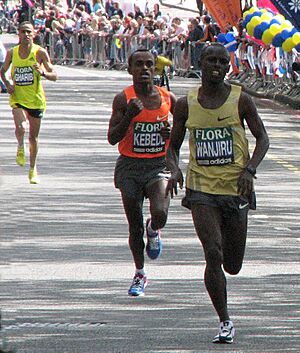
The London Marathon course is mostly flat and covers about 42.195 kilometers (26.2 miles) around the River Thames. The route has markers every mile to help runners know how far they've gone.
The race starts from three different points in Blackheath: the 'red start', 'green start', and 'blue start'. These three paths come together after about 4.5 kilometers (2.8 miles) in Woolwich.
As runners continue, they pass famous landmarks like the Old Royal Naval College and the historic Cutty Sark ship in Greenwich. They then run through areas like Deptford and the Docklands, heading towards Bermondsey. The halfway point is exciting as they cross the iconic Tower Bridge.
After Tower Bridge, the course goes along The Highway through Wapping and into Canary Wharf, a modern area with tall buildings. From Canary Wharf, runners head back towards Limehouse and Commercial Road.
The final part of the race is truly special. Runners pass the Tower of London and then run along The Embankment, where they can see the London Eye. The very last stretch turns into Birdcage Walk, offering views of Big Ben and Buckingham Palace, before finishing at The Mall. This final section was even part of the 2012 Olympic Marathon Course.
The course has changed very little since the first marathon. In 2005, a section around the Isle of Dogs was changed, and a cobblestone area near the Tower of London was avoided to help runners. In 2020, due to the COVID-19 pandemic, the race was run on a special course of laps around St James's Park instead of the usual route.
Amazing Race Results
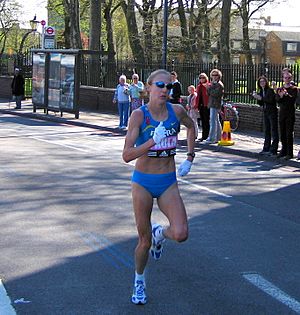
The London Marathon is one of the six biggest marathons in the world, part of the World Marathon Majors competition. The first race in 1981 had 6,255 finishers. The first men's elite race in 1981 was a tie between American Dick Beardsley and Norwegian Inge Simonsen, who finished holding hands! The first women's elite race was won by Briton Joyce Smith.
In 1983, the first wheelchair races were held. Gordon Perry won the men's wheelchair race, and Denise Smith won the women's.
World records for marathon running have been set several times at the London Marathon. Khalid Khannouchi set the men's world record in 2002. The next year, British runner Paula Radcliffe set the women's world record. In 2017, Mary Keitany of Kenya set a world record for an all-women's marathon. The current men's course record is held by Kenyan Kelvin Kiptum (2:01:25 in 2023). The current women's course record is held by Paula Radcliffe (2:15:25 in 2003). For wheelchair races, Marcel Hug of Switzerland set the men's course record in 2021, and Swiss athlete Manuela Schär set the women's record in 2021.
Everyday Heroes: Amateur Runners
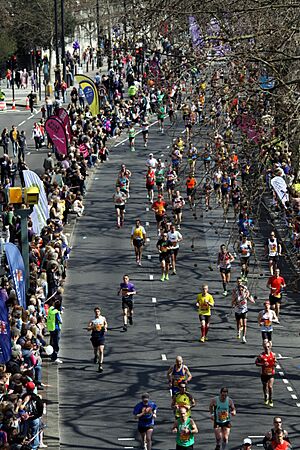
Most of the tens of thousands of people who run the London Marathon are amateur runners. Many of them run in fun costumes to raise money for charity.
There are many inspiring stories from amateur runners. In 2002, Lloyd Scott completed the marathon wearing a heavy deep-sea diving suit, setting a record for the slowest time! In 2003, former boxer Michael Watson, who was told he might never walk again, finished the marathon over six days.
Sir Steve Redgrave, a famous Olympic gold medalist, set a Guinness World Record in 2006 for raising £1.8 million for charity through the marathon. In 2011, Steve Chalke raised an even higher record of £2.32 million. In 2012, Claire Squires sadly passed away during the race, but the £500 she had raised before the race grew to over £1 million after her death, showing how much people care.
A small group of runners, called the "Ever Presents," have completed every single London Marathon since 1981. In 2019, there were 10 of these amazing runners left.
How to Enter the Marathon
There are several ways runners can get a spot in the London Marathon. The most common way is through a Charity Place. This means runners promise to raise a certain amount of money for a registered charity. The London Marathon is very focused on charity running, and it has helped raise over £1 billion since it began.
Another way to enter is through the General Ballot, which is like a lottery. It's become very hard to get a spot this way because so many people want to run. For the 2025 event, over 840,000 people applied! There are also "Good For Age" entries for runners who achieve certain fast times for their age group, and spots for running clubs, celebrities, and elite athletes.
Mini Marathon for Young Athletes
The Virgin Money Giving Mini London Marathon is a special race for younger athletes. It covers the last 3 miles (4.8 kilometers) of the main London Marathon course. This race is for athletes under 13, under 15, and under 17 from all 33 London Boroughs, plus teams from different regions of England and the Home Countries (Scotland, Wales, and Northern Ireland). There's also a Mini Wheelchair race. This event is also the British Athletics 3-mile Championships.
Watching the Race on BBC
The BBC has shown the London Marathon on TV since it started in 1981. Since 1984, they have broadcast the entire race live. Many famous sports presenters and commentators have covered the event over the years. The well-known theme music used by the BBC for the marathon comes from a 1966 film called The Trap.
Who Sponsors the Marathon?
The London Marathon has had several main sponsors over the years. Gillette was the first sponsor from 1981 to 1983. Other sponsors included Mars, ADT, NutraSweet, and Flora. From 2010, Virgin Money was the main sponsor, and the race was called the Virgin Money London Marathon. Since 2022, the Indian company Tata Consultancy Services has been the main sponsor, which is why it's now called the TCS London Marathon. Many other companies also support the event, like New Balance and Lucozade Sport.
See also
- London Triathlon


